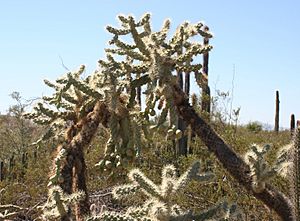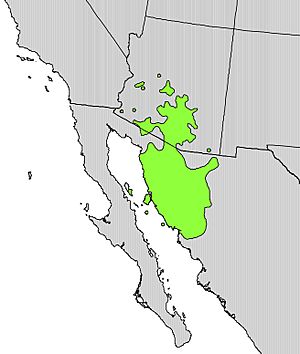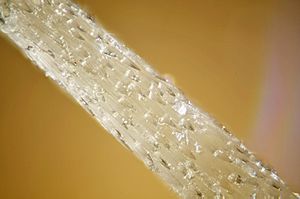Jumping cholla facts for kids
Quick facts for kids Jumping cholla |
|
|---|---|
 |
|
| Scientific classification | |
| Genus: |
Cylindropuntia
|
| Species: |
fulgida
|
 |
|
| Natural range | |
| Synonyms | |
|
Opuntia fulgida |
|
The jumping cholla (scientific name: Cylindropuntia fulgida) is a unique type of cholla cactus. It is also known as the hanging chain cholla because of how its fruits grow. This cactus is native to Sonora, a state in Mexico, and parts of the Southwestern United States.
Contents
Where the Jumping Cholla Grows
The jumping cholla cactus grows mostly across the state of Sonora in Mexico. You won't find it in the eastern mountains there. In the United States, it lives in the Colorado Desert in California and in much of Arizona. It also reaches into the northeast part of the Mojave Desert in southern Nevada and Utah. You can even find it in the very southern tip of the Great Basin Desert in Utah.
What the Jumping Cholla Looks Like
Jumping chollas usually grow in dry areas, from about 1,000 to 3,300 feet (300 to 1,000 meters) above sea level. Even though many chollas are called "jumping cholla," this name especially fits this specific type.
This cactus grows like a small tree, with a single main trunk that branches out low to the ground. It can grow up to 13 feet (4 meters) tall. Its branches often hang down, covered with chains of fruit. The stems are light green and have small, wart-like bumps called tubercles, which are about 0.2 to 0.35 inches (6 to 9 mm) long. Sometimes, these cacti grow so close together that they form large "forests" covering many acres.
Instead of leaves, the jumping cholla has spines. Each small cushion on the stem, called an areole, can have 6 to 12 spines. When the branches are young, these spines are silvery-yellow and about 0.8 to 1.2 inches (2 to 3 cm) long. They turn gray as they get older. These spines are so thick that they hide the stems underneath. Older branches have fewer or shorter spines. As the spines fall off, you can see the brown-black bark, which becomes rough and scaly over time.
The flowers of the jumping cholla are white and pink, with streaks of lavender. They are about one inch (2.5 cm) wide and bloom in mid-summer. You can find them at the tips of the joints or old fruits.
Most of the fruits are green, fleshy, and shaped like a pear or are nearly round. They are wrinkled and have a few spines. These fruits are usually about 1.6 inches (4 cm) long. What's interesting is that these fruits often grow new flowers the next year. This means new fruits can grow onto the old ones, forming long, hanging chains. This is why it's also called the "hanging chain cholla."
Why It's Called "Jumping Cholla"
The name "jumping cholla" comes from how easily its stems break off. If you just brush against the plant, a piece of the cactus can stick to your clothes. You might not even notice it until later when you sit down or lean on it!
The ground around a large jumping cholla plant is often covered with fallen stems. New plants can grow from these pieces. When desert animals brush against the cactus, the stems can stick to their fur. This helps the cactus spread its seeds and grow in new places.
Other names for this cactus include chain fruit cholla, cholla brincadora (which means "jumping cholla" in Spanish), and velas de coyote.
Wildlife and the Jumping Cholla
During dry periods, when there isn't much water, animals like bighorn sheep and some types of deer, such as the desert mule deer, eat the juicy fruit of the jumping cholla. This fruit gives them both food and water. Because these cacti often grow in tough, hard-to-reach parts of the desert, their populations are usually strong and healthy.
See also
 In Spanish: Choya para niños
In Spanish: Choya para niños



